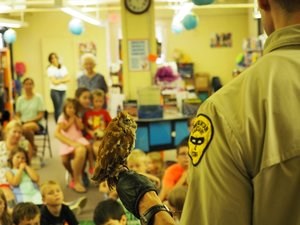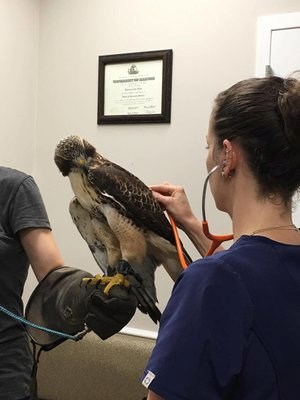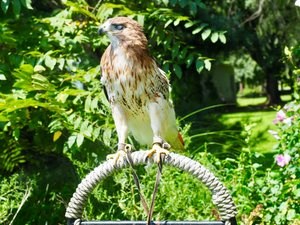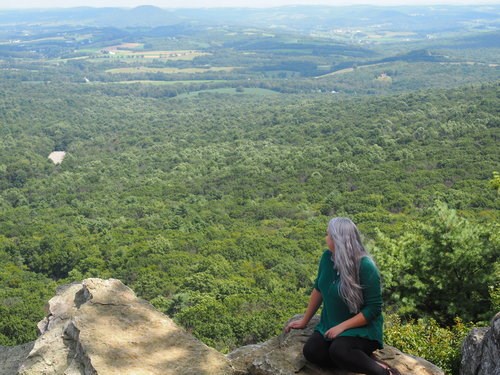One-Health on the Horizon
Posted on in In the Field by Rebekah Smith, Former Education Intern

Hawk Mountain Sanctuary, known worldwide for its revolutionary work on raptor conservation, also uses living education raptors to help inspire and teach others about birds of prey. If you’ve ever wondered how important the jobs of the birds that live at Hawk Mountain Sanctuary are, the answer is as easy as watching the countenance of a young audience when one of our educators introduce our “feathered co-workers.” The majestic animals captivate pupils of all ages and provide that essential connection between the wilderness of the outdoors and our own humanity. This connection is sometimes grievously missing from the current discussions surrounding climate change and public health, and the world is in need of people who can restore it.
The education raptors at Hawk Mountain were once wild birds that were severely injured and rehabilitated at a wildlife rehab center – given a second chance at life. In most cases, wildlife rehab centers are able to release the birds after they are sufficiently functional, however, there are some cases where raptors are deemed unreleasable. This is how education raptors come to be.
The question is, who is responsible for diagnosing, treating, and prescribing medicine to the injured animals both while they are in rehabilitation or while they remain in captivity to be used for education animals? I don’t think many people realize that veterinarians specializing in exotics and wildlife are needed to help care for animals like these and others in captivity all over the world.
The truth is, veterinarians specializing in treating animals other than the traditionally domesticated are vital to conservation efforts worldwide. Not only do wildlife veterinarians work to conserve global biodiversity through the lenses of medicine and animal health, but they also help contribute positively to the one health initiative that many conservation scientists have taken. This initiative usually is defined by understanding the inextricable connection between human health and animal health which hangs in a delicate balance. The spread of disease, environmental toxicity, and even natural disasters are some examples of this connection.

During my time as an education intern at Hawk Mountain Sanctuary, I was able to achieve a clear vision of my future as a wildlife and exotic veterinarian. Hawk Mountain provided me with the chance to watch this career in action, and I made connections with professionals in the field that I will be able to continually draw from for the rest of my career. I had the opportunity to watch a wildlife veterinarian examine and vaccinate all four of the sanctuary’s education raptors. Hawk Mountain’s veterinarian, Dr. Susan Pello, welcomed me to her clinic again soon afterwards where I watched her diagnose and treat an eastern screech owl with a severe eye infection.
Dr. Pello and many other wildlife veterinarians work both at a traditional veterinary clinic and with potential wildlife cases. The future prospects of this career pathway is broadening as we enter an age in which humans are having increasing impact on the general environment and global biodiversity. As people realize that protecting wildlife is a social responsibility both locally and globally, veterinarians will need to step up and offer their specific medical expertise.
When I attended the Jemima Parry-Jones vulture conservation lecture in early September, I found that veterinarians with experience in raptor medicine, nutrition, and captive breeding are desperately needed globally. In Southeast Asia, vultures are commonly poisoned by diclofenac-NSAIDS given to cattle, and their populations are declining rapidly. Electrocution and collision with poerlines are other causes of injury. The ecological role of vultures in such an environment is imperatively bound to the health and wellbeing of the humans that share the land. Vultures are a natural management system for carcasses that can become vectors for disease, bacteria, and other harmful or even deadly microorganisms. As animals continue to die from the shocking changes in climate and weather on a global scale, the ecological need for vultures could potentially increase where we are instead seeing degradation in natural populations.
In captive breeding efforts, veterinarians trained to recognize the health of both the young and adults are needed in order for there to be successful results. Many of the offspring produced in the captive breeding programs suffer from vitamin deficiencies resulting in a dire need for individuals who are well-versed in raptor nutrition and health.

Although this branch of veterinary medicine is still in the midst of developing, it is easy to predict where its future is heading. Not only can veterinarians help animals in the field for ecological and biological research, but they can also aid in the overwhelming need for general education that we hope will create the behavioral changes necessary to minimize the negative impacts of human beings on natural populations of animals such as birds of prey.
I am a firm believer that getting the opportunity to connect with an animal face-to-face can affect your own personal daily decisions that make an environmental difference when broadened in the lens of the over-all human population. Many of the potential solutions to issues in conservation come from a pool that reaches many different bodies of expertise. We cannot simply expect our problems to be solved without the contribution of the knowledgeable and their efforts. Veterinary medicine is just one facet to the mosaic of the one-health initiative that ultimately aspires to nurture the ecological balance between humans and animals globally.
